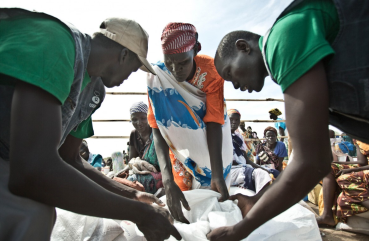Famine warning for S. Sudan downgraded, but hunger still looms
September 24, 2014 (JUBA) – International humanitarian agencies working in war-torn South Sudan have welcomed the easing of famine warnings for the country after the Integrated Food Security Phase (IPC) reported that the number of people at risk stood at 1.5 million, down from 3.7 million in May.

This is due largely to a massive aid response and an improvement in food availability after good seasonal rains.
“While there are significant improvements since the May IPC, the situation is much worse compared to a typical year at harvest time,” the IPC said in its report.
HUNGER LOOMS IN 2015
However, it has warned that despite the progress since May, the outlook for 2015 remains grim, with 2.5 million people projected to be living in severe hunger from January to March based on current trends.
The UN World Food Programme (WFP) says this includes nearly half of the populations in the conflict-affected states of Jonglei, Upper Nile and Unity.
“Food security is improving, which is good news, but we are not out of the woods yet,” said Joyce Luma, WFP South Sudan country director.
“The situation remains fragile, and a hunger catastrophe will continue to be a threat well into next year, especially if fighting continues. It is absolutely critical to sustain the humanitarian effort,” she added.
In a separate statement on Wednesday, the International Rescue Committee (IRC) and the UN Children’s Fund (UNICEF) applauded the report, but warned donors against relaxing aid.
“This is good news [that] famine has been averted in South Sudan this year as a result of good rains and the massive emergency aid operation,” IRC said.
Humanitarian agencies, however, warn that the study only covers the September to December period and that the situation is expected to deteriorate sharply in 2015 as food stocks run out, with the crisis likely to be exacerbated further if South Sudan’s warning parties fail to agree on a permanent peace accord.
DONOR FUNDS NEEDED
UNICEF said that $25 million is still needed in “urgent additional funding” to complete its nutrition response and to preposition life-saving supplies during the coming dry season, while the WFP is facing a funding shortfall of $345 million to continue its work in South Sudan for the next six months.
The WFP says the need for humanitarian relief will continues throughout this year, and that efforts will need to be stepped up early next year to help people rebuild livelihoods, and to prevent an escalation in food security and malnutrition in 2015.
“Donor support has allowed us to provide life-saving assistance so far, but we must not relent in our efforts, and we do need more resources to do that,” Luma said.
South Sudan has been mired in a brutal armed struggle since mid-December last year after a political split in the country’s ruling party turned violent.
The fighting has severely disrupted crop plantings and agricultural activities across the country, leading to critical food shortages.
The crisis plunged the young nation to the brink of a humanitarian disaster, with aid agencies repeatedly warning of a looming famine should government and rebel forces cease hostilities.
Humanitarian agencies have mounted a major relief effort in response to the crisis in South Sudan, with the WFP using airlifts, airdrops, trucks and barges to deliver food and nutrition supplies for large-scale distributions.
In remote areas, joint emergency response teams are providing food, nutrition and livelihood assistance along with emergency health and protection services. Aid agencies are also providing support to displaced civilians sheltering in UN-protected camps where conditions remain difficult.
The IPC analysis was conducted by food security and humanitarian assessment specialists from a number of aid and development agencies, as well as technical experts from the South Sudanese government.
(ST)
